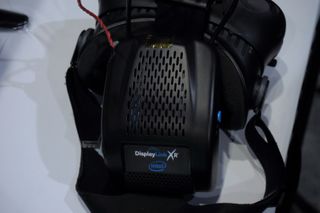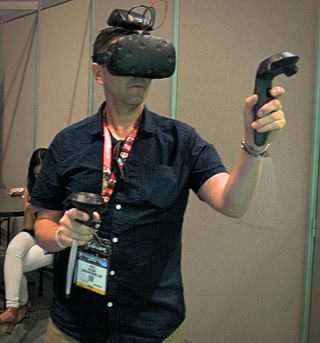Intel Demos HTC Vive WiGig Module

At Computex, Intel announced a partnership with HTC to provide WiGig support for the HTC Vive with the promise of eliminating all of those annoying cables that truly inhibit the freedom of movement you'd expect (or at least desire) in VR. During E3 this week, Intel was showing a prototype of the module behind closed doors, and we had a chance to try it out.
The module contains the wireless transmitter/receiver, a battery to power the module and the HMD, and DisplayLink's codec. It's wired into the HMD where the normal 10-foot cables connect. Keep in mind that this is merely a prototype. HTC will be able to take the prototype, conduct user experience testing, and implement the module in a way that accounts for the module's extra weight, among other factors. Naturally those unseemly wires will get hidden. HTC may also opt to decouple the battery, putting it on something that might clip to your belt, for example. This would lighten the load even more.

We played Space Pirate Trainer, one of the early Vive titles, which is easy enough to play and features enough action to get a sense of whether or not there's any significant lag being introduced. Although the module seemed a bit unwieldy at a glance, in practice it merely added a bit of extra weight, and it shifted a little on our head as we whipped it from side to side, but with some obvious refinements, we'd wager that this will all be solved. Even at that, we were able to play the game quite naturally, without thinking too much about the extra module.
The WiGig module is sending sensor and display data over a 60GHz transport, adding a few milliseconds of latency to an already meager latency budget. Intel did not disclose some of the nitty-gritty details about how that's being managed, other than to say that we're talking about some of the same predict-ahead techniques already being used to overcome latency concerns when the technology is trying to match captured sensor data (head and hand and gesture motion and position) with what your brain expects to see.
Timewarp, or re-projection techniques, are naturally at play here, and Intel has worked with Valve on the software stack and with HTC on the hardware stack to take advantage of those. We'll have to assume that just a bit more forecasting is being incorporated into the display pipeline. In our trial with Space Pirate Trainer, we didn't notice any lag. It's one of our blow-off-steam games, so we've got at least enough experience with it to make that subjective call, but then we didn't play it long enough to draw any hard conclusions. Still, this is promising.

We've tried and tested other, similar wireless modules for VR, including Sixa's Rivvr Wireless VR, which uses 2.4GHz and 5GHz WiFi, rather than WiGig. TPCAST also announced a wireless VR module that works with the HTC Vive, and Quark VR did the same. However, Intel's play here is WiGig, which provides a faster transport and, thus, theoretically less lag. The problem, of course, is that you'll need WiGig on your PC. Intel had a couple of WiGig prototypes on display as well, including a PCIe add-on card and an external Thunderbolt adapter, both pictured above.
All of this also begs the question about developments like Intel's own Project Alloy and Oculus' Santa Cruz efforts, which are both standalone, self-contained VR solutions. Because the processing that can be done within a self-contained HMD is limited by power and thermal hurdles, Intel believes both markets (the self-contained HMD and the PC-connected HMD) will be viable, and will be driven by the applications and their resource demands.
Stay on the Cutting Edge
Join the experts who read Tom's Hardware for the inside track on enthusiast PC tech news — and have for over 25 years. We'll send breaking news and in-depth reviews of CPUs, GPUs, AI, maker hardware and more straight to your inbox.
The timeframe for an Intel WiGig module for the Vive now rests entirely on HTC, and Intel wouldn't speculate on it, or even on if we'll see it this year. Intel is working with multiple partners, but when we pressed them on Oculus, Intel would not comment. Clearly, we're a bit far off on this, given that we're just seeing a prototype and WiGig implementations are practically non-existent, but all of the activity around solving the VR cabling issue is promising nonetheless.
-
dstarr3 Even if it meant strapping a bandolier of batteries across my chest to keep a wireless HMD running for a decent amount of time, totally worth it.Reply -
cryoburner Reply
I suspect we'll see both of those markets converge fairly soon. Really, there's no reason a headset couldn't have both self-contained functionality, and a wireless transmitter to work with PC/console VR. When used with another device, the standalone rendering capabilities could likely be used to perform things like perspective adjustments on the headset itself to match the latest positional data before it even gets transmitted to the PC, helping to cut down on perceived latency.19816385 said:Because the processing that can be done within a self-contained HMD is limited by power and thermal hurdles, Intel believes both markets (the self-contained HMD and the PC-connected HMD) will be viable, and will be driven by the applications and their resource demands. -
computerguy72 Jason - it's 802.11.ad at 60Ghz. Looks very promising and like the next gen is shaping up. So as accessories Vive has the new strap, integrated sound, additional trackers, 2 wireless solutions and a nice smattering of AAA titles. Just need an updated hmd, sleeker, higher pixel density and fov and we have something really special.Reply -
jdlech I figure it's just a matter of time before we see people watching movies in 4K on their smart phones. It seems society is diving headlong into the most vapid and pointless use of technology we can possibly imagine.Reply
Most Popular


